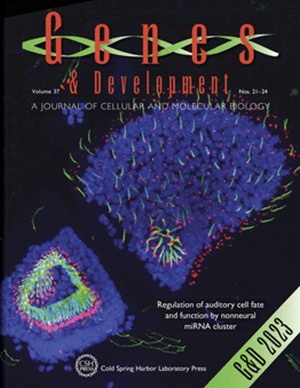Fatty acid uptake activates an AXL–CAV1–β-catenin axis to drive melanoma progression
IF 7.7
1区 生物学
Q1 CELL BIOLOGY
引用次数: 0
Abstract
Interaction between the tumor microenvironment and cancer cell plasticity drives intratumor phenotypic heterogeneity and underpins disease progression and nongenetic therapy resistance. Phenotype-specific expression of the AXL receptor tyrosine kinase is a pivotal player in dormancy, invasion, and resistance to treatment. However, although the AXL ligand GAS6 is present within tumors, how AXL is activated in metastasizing cells remains unclear. Here, using melanoma as a model, we reveal that AXL is activated by exposure to human adipocytes and to oleic acid, a monounsaturated fatty acid abundant in lymph and in adipocytes. AXL activation triggers SRC-dependent formation and nuclear translocation of a β-catenin–CAV1 complex required for melanoma invasiveness. Remarkably, only undifferentiated AXLHigh melanoma cells engage in symbiosis with human adipocytes, in part by triggering WNT5a-mediated lipolysis, leading to AXL-dependent, but FATP-independent, fatty acid uptake and nuclear localization of the β-catenin–CAV1 complex. Significantly, human melanomas in the vicinity of adipocytes exhibit high levels of nuclear CAV1. The results unveil an AXL- and CAV1-dependent mechanism through which a nutritional input drives phenotype-specific activation of a prometastasis program. Given the key role of AXL in a broad range of cancers, the results offer major insights into the mechanisms of cancer cell dormancy and therapy resistance.脂肪酸摄取激活AXL-CAV1 -β-catenin轴驱动黑色素瘤进展
肿瘤微环境和癌细胞可塑性之间的相互作用驱动肿瘤内表型异质性,并支持疾病进展和非基因治疗耐药性。AXL受体酪氨酸激酶的表型特异性表达在休眠、侵袭和抵抗治疗中起关键作用。然而,尽管AXL配体GAS6存在于肿瘤中,但AXL如何在转移细胞中被激活尚不清楚。在这里,我们以黑色素瘤为模型,揭示了暴露于人类脂肪细胞和油酸(一种在淋巴和脂肪细胞中丰富的单不饱和脂肪酸)时,AXL被激活。AXL激活触发src依赖的β-catenin-CAV1复合体的形成和核易位,这是黑色素瘤侵袭所必需的。值得注意的是,只有未分化的AXLHigh黑色素瘤细胞与人脂肪细胞共生,部分原因是通过触发wnt5a介导的脂肪分解,导致β-catenin-CAV1复合物依赖axl,但不依赖fatp的脂肪酸摄取和核定位。值得注意的是,脂肪细胞附近的人类黑色素瘤表现出高水平的核CAV1。研究结果揭示了一种依赖于AXL和cav1的机制,通过这种机制,营养输入驱动了转移前程序的表型特异性激活。鉴于AXL在多种癌症中的关键作用,该结果为癌细胞休眠和治疗抵抗的机制提供了重要见解。
本文章由计算机程序翻译,如有差异,请以英文原文为准。
求助全文
约1分钟内获得全文
求助全文
来源期刊

Genes & development
生物-发育生物学
CiteScore
17.50
自引率
1.90%
发文量
71
审稿时长
3-6 weeks
期刊介绍:
Genes & Development is a research journal published in association with The Genetics Society. It publishes high-quality research papers in the areas of molecular biology, molecular genetics, and related fields. The journal features various research formats including Research papers, short Research Communications, and Resource/Methodology papers.
Genes & Development has gained recognition and is considered as one of the Top Five Research Journals in the field of Molecular Biology and Genetics. It has an impressive Impact Factor of 12.89. The journal is ranked #2 among Developmental Biology research journals, #5 in Genetics and Heredity, and is among the Top 20 in Cell Biology (according to ISI Journal Citation Reports®, 2021).
 求助内容:
求助内容: 应助结果提醒方式:
应助结果提醒方式:


